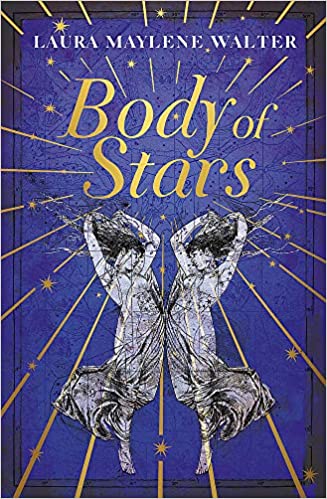
In the alternative world of Body of Stars, women are born with markings on their bodies that predict their futures. During a vulnerable transition from child to woman, when girls are called changelings and their senses are heightened, their markings alter overnight, creating patterns that fix their futures on their skin. The markings and their interpretation are noted and regulated by the state through a book called Mapping the Future: An Interpretive Guide to Women and Girls. Men have no such markings, their future and skins blank, and they are denied the authority to interpret.
During a girl’s transition to womanhood their beauty, alongside their sensory perception, is heightened. They are warned of how vulnerable they are to male attention and desire. They are encouraged to cover up, never walk alone, and stay home after dark.
The novel tracks Celeste’s transition from her girlhood markings to her adult markings. We follow her as she moves from one state to another, attempting to understand her role in life through the confines of her skin. A skin her brother, Miles, has always been fascinated by. He has examined, drawn and redrawn a particular patch near her left elbow and he has managed to find a woman to teach him interpretation even though it is forbidden for men to become interpreters.
As well as her own future, a woman’s markings predict the futures of those close to her. The futures of siblings, children, husbands and other relatives can be read in the disparate moles and freckles.
I’m not going to say more about the plot because that would spoil some of the joy of reading the novel. More than the plot, what excited me about this novel was its attempt to compare the women of this world, with the women in our own. To what extent are women’s futures mapped out on their bodies? To what extent are women in our world defined by the violence and desires of men, whose actions are sanctioned by the supposed irresponsibility of women’s behaviour and by an understanding that girls of a certain age are irresistible? In Body of Stars, the burden of responsibility is firmly placed on the victim and not the perpetrator. The changeling girls accounts can’t be trusted, so when they are abducted and abused, the perpetrators of the violence cannot be found or prosecuted because the girls’ accounts aren’t reliable. Their word is not enough. The comparisons to our world suddenly become glaringly blatant and the onus for change should not be on the girls – those elbow markings of Celeste’s are significant – but on the abusers.
These comparisons make the book powerfully political. I’m not arguing that everything the novel propounds is something we might all agree on, but it does raise interesting questions about our socialisation of boys and girls and our expectations for each. Our future should not be mapped on our skin and we should do all we can to make sure everyone has choice in their lives. No easy feet, but something worth aiming for. Most importantly of all, change is a shared responsibility.
Laura Maylene Walter writes a fascinating debut that bristles with relevance to our modern lives. She shows how genre fiction that mixes dystopian, magical realism and speculative fiction, can speak directly to contemporary life. It’s a quick and compelling read with some difficult questions to ask and the illustrations are wonderful too. It will be exciting to see what she writes next.
I’ll be reviewing Mrs Death Misses Death by Salena Godden next.